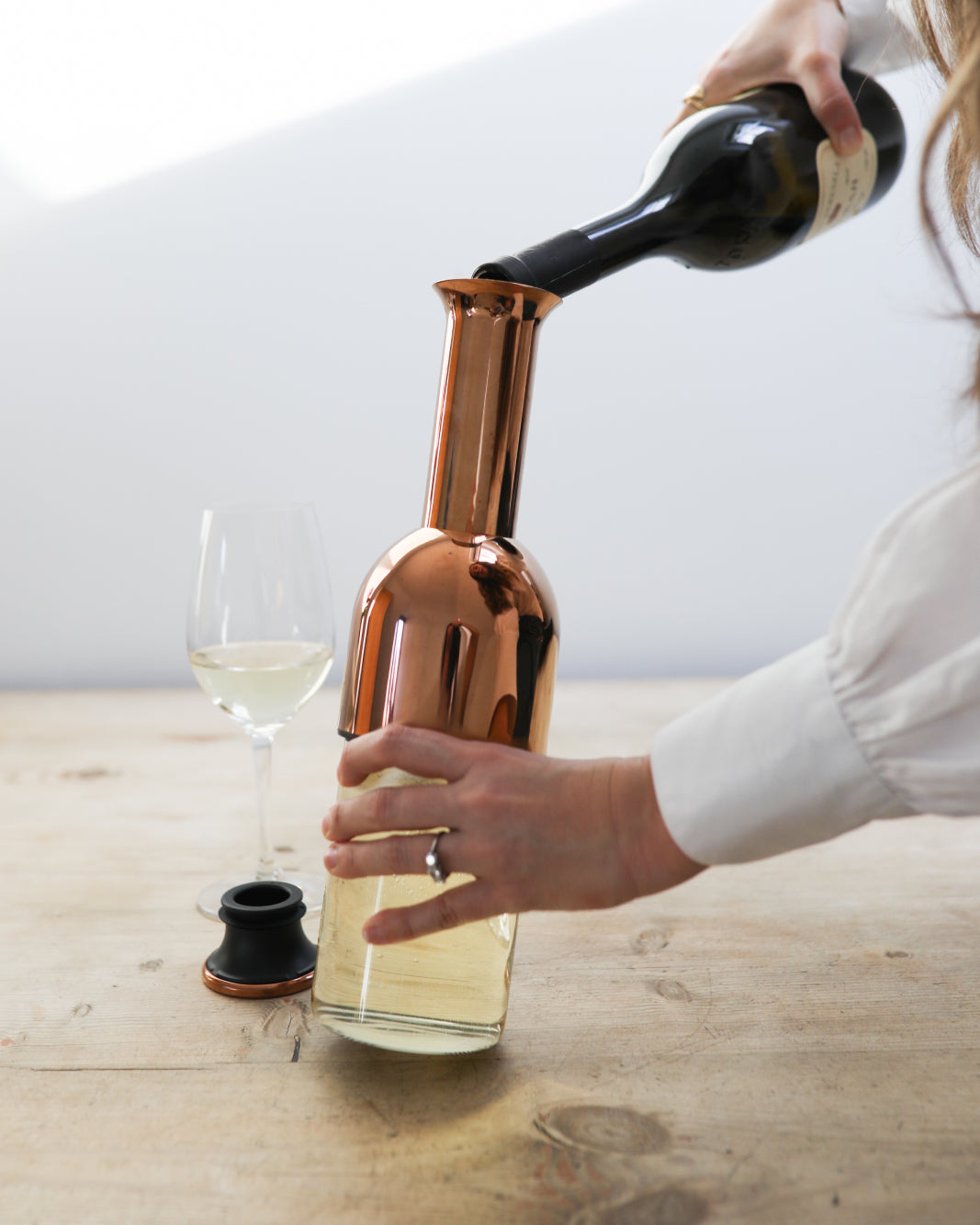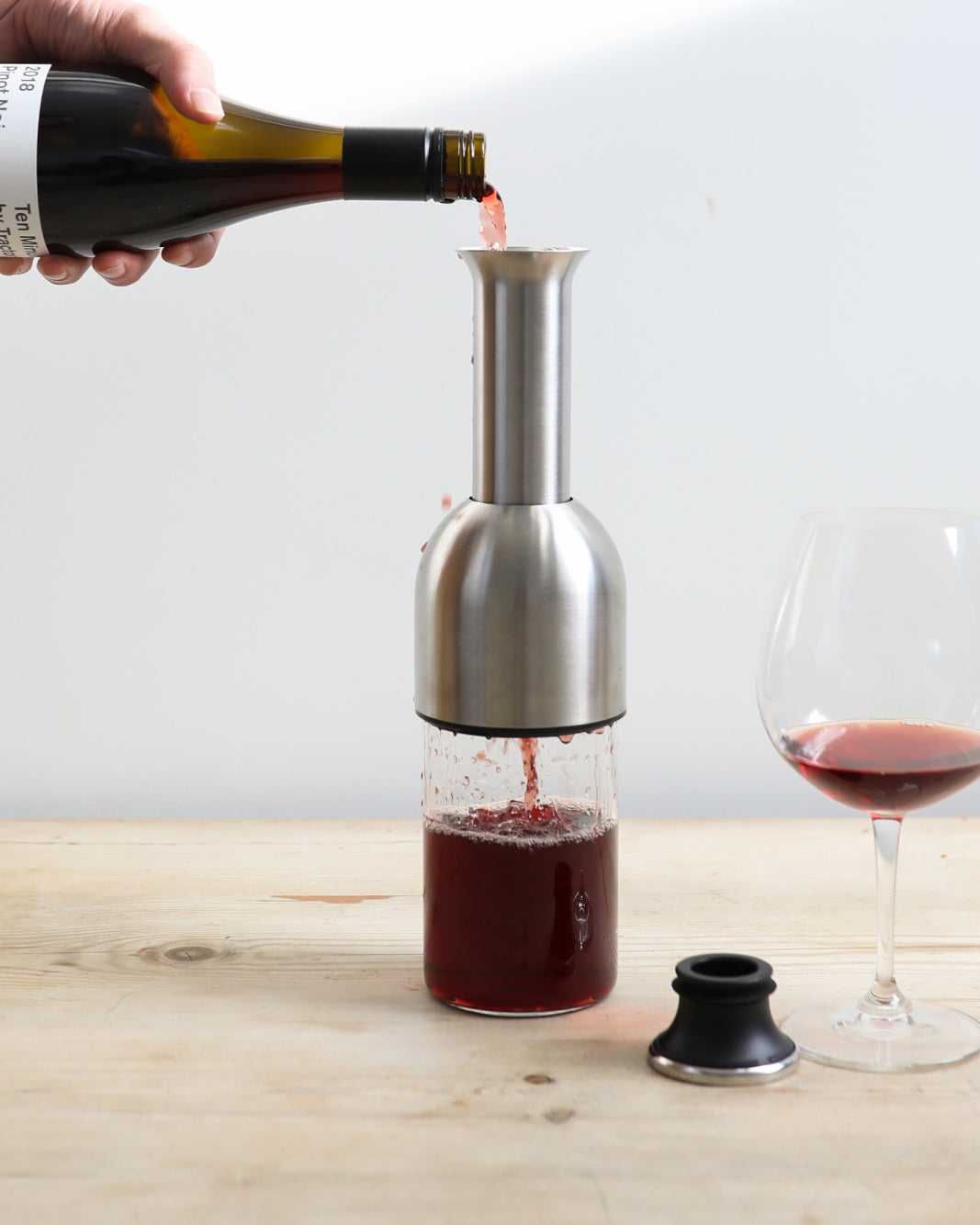De-mystifying decanting: The how, why, and when of decanting wine
13.09.23
•5 min read
13.09.23
•5 min read
Decanting wine is principally about improving the taste experience – and this article focuses on explaining how that works. But decanting wine has cultural significance too. The act brings a sense of ceremony to an occasion like a dinner party, marking out the bottle of wine – and by extension the event itself – as special. An elegant decanter as a centrepiece on a dining table also adds to the overall aesthetic of the space, much more than a regular wine bottle could do.
There are many different reasons why it’s good to decant your wine, from removing the sediment in older wine, to softening the sharp tannins in young reds. Here are the main benefits of decanting wine.
As wines age, they develop sediment. While it’s not dangerous to drink, sediment can make the wine cloudy and leave a gritty taste – so it’s always a good idea to take steps to separate and remove it, especially if you’re drinking a wine that’s five years old or more. By following the correct process for decanting wine (see later) sediment can be removed very effectively, leaving you with a clear and smooth tasting bottle of wine.
Decanting your bottle brings the wine into contact with the oxygen in the air, which in turn releases its aromatic compounds. As smell is so central to our appreciation of flavour – our taste buds can only detect four tastes (sweet, sour, bitter and salty) and anything more nuanced relies on smell – awakening the aromas makes a huge difference to our taste experience. The flavours are more pronounced and it’s much easier to identify the subtle fruits and spices within the wine.
Oxygen also reacts with the wine to soften the tannins. Tannins are natural compounds in red wine, but they can be sharp in flavour, especially in some young reds. Allowing the wine to interact with the oxygen in the air softens and smooths out their taste.

At its most basic, a wine decanter is a container that stores wine – and the verb ‘to decant’ is the action of pouring wine from its bottle into a separate vessel. As the main reason for decanting wine is to expose the wine to oxygen, it is the action of pouring rather than the container itself that is key.
However, there are lots of things you can look for when choosing the right decanter for you. Firstly, its aesthetic. Decanters are designed for style as well as substance, so choose a decanter that you love the look of – and believe would make a stylish centrepiece on your table. Most people prefer to see the wine within the decanter clearly too – so crystal, glass or borosilicate are the best materials.
But practical considerations are also important. For example, how easy the decanter is to fill initially, and then whether you can pour from it without the risk of spilling. A decanter with wow factor might look amazing on your table, but could also prove tricky to hold and pour from. Other practical factors include how simple it is to clean after use, and how resilient it feels. And if you have wine left over at the end of the evening, whether you can store the decanter easily.
To make sure all the sediment settles at the bottom, stand the bottle you want to decant upright for at least a few hours before decanting, and preferably overnight. Then when you’re ready to decant, pour the wine slowly and carefully with a stable grip to avoid stirring up the sediment. As you reach the end of the bottle, keep an eye out, and stop pouring just before you reach the sediment. Once decanted, let the wine breathe . . .

This depends on the wine. The act of decanting your wine speeds up the breathing process, but you should always wait a while before pouring a glass (for red wine) because a wine’s aroma changes during the first 20 minutes of its exposure to the air. For light-bodied wines like Pinot Noir, this period of time is long enough. For medium-bodied wines like Merlot, let the wine breath for 30-45 minutes. And full-bodied wines like Malbec or Cabernet Sauvignon take an hour or so to reach their perfect flavour. The age of the wine affects the ideal breathing time too. Older red wines are best decanted two hours before serving.
And don’t forget that exposing wine to oxygen for too long has a detrimental effect on its quality.
Only sparkling wines shouldn’t be decanted – because the wine loses its fizz. Other than that, there are differing benefits. Older red wines that have built up sediment should always be decanted, as should young red wines with intense tannins like Malbec, Shiraz and Bordeaux. White wines are best decanted just before serving because the aeration releases the aromas quickly – and this also means you can keep the wine chilled until you’re ready for a glass. Young whites with high acidity like Rieslings and Chenin Blancs benefit most from decanting compared to other white wine grapes.
Decanters come in lots of different styles and shapes – from the swan to the duck, and from traditional to contemporary – so choose the decanter you like best. But remember to consider the practical elements of a new decanter as well as how good it will look on your table.
With eto, we aim to offer both a beautiful aesthetic and peerless practical benefits. The design is sleek and elegant, and each decanter is hand-finished using high-quality stainless steel and borosilicate glass. The long funnel elongates the design, but it also gently oxygenates the wine to release its flavour during pouring. Eto has a sharp lip which means no drips on your table. And it fits perfectly inside a standard fridge door, so it’s easy to chill your wine. Eto dissembles into six parts which makes it super-easy to clean too.
But even better than that . . . As well as being a beautiful decanter, eto also preserves your wine by preventing oxidisation. Store your wine in eto in the fridge, and enjoy the same bottle for up to two weeks. It will taste just as delicious as it did on the day you decanted it.
Find out more about using eto here.
Discover more about how long wine lasts in our previousarticle